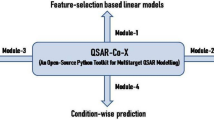Abstract
The quantitative structure–activity relationships method was popularized by Hansch and Fujita over 50 years ago. The usefulness of the method for drug design and development has been shown in the intervening years. As it was developed initially to elucidate which molecular properties modulated the relative potency of putative agrochemicals, and at a time when computing resources were scarce, there is much scope for applying modern mathematical methods to improve the QSAR method and to extending the general concept to the discovery and optimization of bioactive molecules and materials more broadly. I describe research over the past two decades where we have rebuilt the unit operations of the QSAR method using improved mathematical techniques, and have applied this valuable platform technology to new important areas of research and industry such as nanoscience, omics technologies, advanced materials, and regenerative medicine. This paper was presented as the 2017 ACS Herman Skolnik lecture.




Reproduced with permission from [13]

Reproduced with permission from Hook et al. [25]

Reproduced with permission from [40]

Reproduced with permission from [41]


Reproduced with permission from [42]. Copyright 2015 National Academy of Sciences

Figure 10(b) reproduced with permission from Hook et al. [25]

Reproduced with permission from Thornton et al. [48]
Similar content being viewed by others
References
Mitchell M (2009) Complexity: a guided tour. Oxford University Press, Oxford
Halley JD, Winkler DA (2008) Complexity 14(2):10
Halley JD, Winkler DA (2008) Complexity 13(5):10
Bhadeshia HKDH. (1999) ISIJ Int 39(10):966
Epa VC, Burden FR, Tassa C, Weissleder R, Shaw S, Winkler DA (2012) Nano Letters 12(11):5808
Winkler DA, Burden FR (2012) Mol Biosyst 8(3):913
Hansch C, Maloney PP, Fujita T (1962) Nature 194(4824):178
Hansch C, Fujita T (1964) J Am Chem Soc 86(8):1616
Fujita T, Winkler DA (2016) J Chem Inf Model 56(2):269
Le T, Epa VC, Burden FR, Winkler DA (2012) Chem Rev 112(5):2889
Gedeck P, Rohde B, Bartels C (2006) J Chem Inf Model 46(5):1924
Clark M, Cramer RD (1993) Quant Struct Act Rel 12(2):137
Alexander DLJ, Tropsha A, Winkler DA (2015) J Chem Inf Model 55(7):1316
Hansch C, Fujita T (1995) ACS Sym Ser 606:1
Kubinyi H (1990) J Cancer Res Clin 116(6):529
Niculescu SP (2003) J Mol Struct 622(1–2):71
Burden FR, Rosewarne BS, Winkler DA (1997) Chemometr Intell Lab Syst 38(2):127
Burden FR, Winkler DA (1999) J Chem Inf Comput Sci 39(2):236
Winkler D (2001) Drug Discov Today 6(23):1198
Winkler DA (2004) Mol Biotechnol 27(2):139
Burden FR, Polley MJ, Winkler DA (2009) J Chem Inf Model 49(3):710
Winkler DA, Burden FR, Watkins AJR (1998) Quant Struct Act Rel 17(1):14
Burden FR, Winkler DA (2005) J Mol Graph Model 23(6):481
Gómez-Bombarelli R, Wei JN, Duvenaud D, Hernández-Lobato J, Sánchez-Lengeling B, Sheberla D, Aguilera-Iparraguirre J, Hirzel TD, RAdams RP, Aspuru-Guzik A (2018) ACS Cent Sci ASAP. https://doi.org/10.1021/acscentsci.7b00572
Hook AL, Chang CY, Yang J, Luckett J, Cockayne A, Atkinson S, Mei Y, Bayston R, Irvine DJ, Langer R, Anderson DG, Williams P, Davies MC, Alexander MR (2012) Nat Biotechnol 30(9):868
Topliss JG, Costello RJ (1972) J Med Chem 15(10):1066
Figueiredo MAT (2003) IEEE Trans Pattern Anal Mach Intell 25(9):1150
Burden FR, Winkler DA (2009) QSAR Comb Sci 28(6–7):645
Burden FR, Winkler DA (2009) Bayesian regularization of neural networks. In: Livingston D (ed) Artificial neural networks: methods and applications, vol 458. Humana Press, Totowa
Burden FR, Winkler DA (2015) J Chem Inf Model 55(8):1529
Hornik K (1991) Neural Netw 4(2):251
Burden FR, Winkler DA (2009) QSAR Comb Sci 28(10):1092
Burden FR, Winkler DA (1999) J Med Chem 42(16):3183
Winkler DA, Le TC (2017) Mol Inf 36:(1–2)
Burden FR, Ford MG, Whitley DC, Winkler DA (2000) J Chem Inf Comput Sci 40(6):1423
Salahinejad M, Le TC, Winkler DA (2013) Mol Pharmaceut 10(7):2757
Winkler DA (2016) Toxicol Appl Pharmacol 299:96
Winkler DA, Mombelli E, Pietroiusti A, Tran L, Worth A, Fadeel B, McCall MJ (2013) Toxicology 313(1):15
Mauri A, Consonni V, Pavan M, Todeschini R (2006) Match Commun Math Comput Sci 56(2):237
Epa VC, Hook AL, Chang C, Yang J, Langer R, Anderson DG, Williams P, Davies MC, Alexander MR, Winkler DA (2014) Adv Funct Mater 24(14):2085
Mikulskis P, Hook AL, Alexander MH, Winkler DA (2018) ACS Appl Mater Interfaces 10(1):139–149
Autefage H, Gentleman E, Littmann E, Hedegaard MAB, Von Erlach T, O’Donnell M, Burden FR, Winkler DA, Stevens MM (2015) Proc Natl Acad Sci USA 112(14):4280
Cybenko G (1989) Math Control Signal Syst 2(4):303
Le TC, Winkler DA (2015) ChemMedChem 10(8):1296
Le TC, Winkler DA (2016) Chem Rev 116(10):6107
Puentedura RR (2003) The Baldwin effect in the age of computation. In: Weber BH, Depew DJ (eds) Evolution and learning: the Baldwin effect reconsidered. MIT Press, Cambridge
Hinton GE, Nowlan SJ (1987) Complex Syst 1:495
Thornton AW, Simon CM, Kim J, Kwon O, Deeg KS, Konstas K, Pas SJ, Hill MR, Winkler DA, Haranczyk M, Smit B (2017) Chem Mater 29(7):2844
Nowak-Sliwinska P, Weiss A, Ding X, Dyson PJ, van den Bergh H, Griffioen AW, Ho C-M (2016) Nat Protoc 11:302
Acknowledgements
I would like to acknowledge the very talented members of my group, Frank Burden (my long-term collaborator in neural networks), Vidana, Epa, Anna Tarasova, Julianne Halley, Mitch Polley, Tu Le, and my current collaborators at CSIRO, Imperial College, MIT, and Nottingham. Their contributions are captured in the cited publications and I’m extremely grateful for their dedication and valuable intellectual contributions. I’ve also been very fortunate to have some excellent mentors during my career. I’m especially grateful to Prof. Toshio Fujita, Prof. Peter Andrews, and Prof. Graham Richards for valuable guidance and mentorship. I would also like to thank the ACS for the Herman Skolnik award and travel support, and the speakers in the Skolnik symposium for their great support. Support of UK Engineering and Physical Sciences Research Council (EPSRC) Grant EP/N006615/1 for the Programme Grant in Next Generation Biomaterials Discovery and a Monash University-Nottingham travelling fellowship are also gratefully acknowledged.
Author information
Authors and Affiliations
Corresponding author
Rights and permissions
About this article
Cite this article
Winkler, D.A. Sparse QSAR modelling methods for therapeutic and regenerative medicine. J Comput Aided Mol Des 32, 497–509 (2018). https://doi.org/10.1007/s10822-018-0106-1
Received:
Accepted:
Published:
Issue Date:
DOI: https://doi.org/10.1007/s10822-018-0106-1




